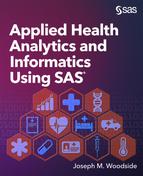Book Description
Leverage health data into insight!Applied Health Analytics and Informatics Using SAS describes health anamatics, a result of the intersection of data analytics and health informatics. Healthcare systems generate nearly a third of the world’s data, and analytics can help to eliminate medical errors, reduce readmissions, provide evidence-based care, demonstrate quality outcomes, and add cost-efficient care. This comprehensive textbook includes data analytics and health informatics concepts, along with applied experiential learning exercises and case studies using SAS Enterprise MinerTM within the healthcare industry setting. Topics covered include:
- Sampling and modeling health data – both structured and unstructured
- Exploring health data quality
- Developing health administration and health data assessment procedures
- Identifying future health trends
- Analyzing high-performance health data mining models
This book is part of the SAS Press program.
